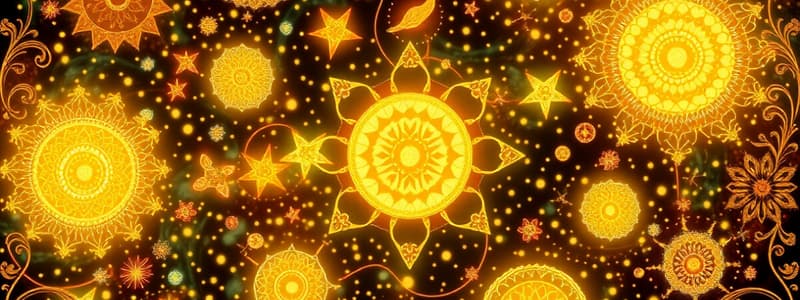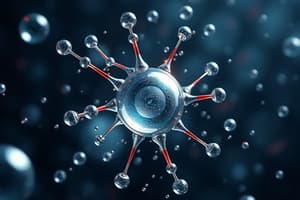Podcast
Questions and Answers
What does the law of conservation of mass state?
What does the law of conservation of mass state?
- Matter can change forms but does not change in mass.
- Mass can be created or destroyed in a chemical reaction.
- The total mass of reactants equals the total mass of products in a chemical reaction. (correct)
- Mass is only transferred, not altered, in a chemical reaction.
Which of the following descriptions is accurate for the plum-pudding model of the atom?
Which of the following descriptions is accurate for the plum-pudding model of the atom?
- It shows a nucleus surrounded by orbiting electrons.
- It depicts electrons embedded in a dense positive sphere. (correct)
- It illustrates electrons orbiting a liquid core.
- It represents atoms as solid indivisible particles.
In Rutherford's gold foil experiment, what did he conclude about the structure of the atom?
In Rutherford's gold foil experiment, what did he conclude about the structure of the atom?
- The positive charge is diffused throughout the atom.
- Atoms consist solely of negatively charged electrons.
- All atoms have a uniform density.
- Atoms are mostly empty space with a small dense nucleus. (correct)
What is the difference between the atomic number (Z) and the mass number (A)?
What is the difference between the atomic number (Z) and the mass number (A)?
How is percent natural abundance of isotopes determined?
How is percent natural abundance of isotopes determined?
Which of the following best defines an ion?
Which of the following best defines an ion?
What distinguishes ionic compounds from molecular (covalent) compounds?
What distinguishes ionic compounds from molecular (covalent) compounds?
How do you determine the empirical formula from percent by mass of elements in a compound?
How do you determine the empirical formula from percent by mass of elements in a compound?
Flashcards are hidden until you start studying
Study Notes
Chapter 2: Atoms and Elements
- Law of Conservation of Mass: Matter cannot be created or destroyed in a chemical reaction; the mass of reactants equals the mass of products.
- Plum-Pudding Model: Proposed by J.J. Thomson, this model depicts the atom as a sphere of positive charge with negatively charged electrons embedded within it, resembling a "plum pudding."
- Rutherford’s Gold Foil Experiment: Demonstrated that atoms have a small, dense nucleus; most of the atom's volume is empty space, as most alpha particles passed through gold foil, while some were deflected.
- Subatomic Particles:
- Protons: Positive charge, mass of approximately 1 amu.
- Neutrons: No charge, mass of approximately 1 amu.
- Electrons: Negative charge, negligible mass (approximately 1/1836 amu).
- Atomic Number (Z) vs. Mass Number (A): Z indicates the number of protons in an atom; A is the sum of protons and neutrons.
- Isotopes: Atoms of the same element that have different numbers of neutrons, resulting in different mass numbers.
- Percent Natural Abundance of Isotopes: The relative percentage of each isotope found in nature, usually determined by mass spectrometry.
- Average Atomic Mass Calculation: Use the masses and natural abundances of isotopes to compute the weighted average atomic mass of an element.
- Ions: Charged particles formed when atoms gain or lose electrons; can be cations (positively charged) or anions (negatively charged).
- Predicting Ion Charges: Generally, main-group elements form ions that achieve a stable electron configuration, typically resembling the nearest noble gas.
- Mole Concept: A mole is 6.022 x 10²³ particles (atoms, molecules) of a substance. Calculations can involve converting between mass, moles, and number of atoms.
- Mass Variability Between Elements: Each element has a unique atomic mass due to differences in the number of protons and neutrons.
Chapter 3: Matter, Measurement, and Problem Solving
- Chemical Bonds:
- Ionic Compounds: Formed between metals and non-metals where electrons are transferred, resulting in attraction between oppositely charged ions.
- Molecular (Covalent) Compounds: Composed of two or more non-metals sharing electrons to form molecules.
- Ionic Compound Neutrality: Ionic compounds must have overall neutral charge, determined by the charges of contributing ions.
- Nomenclature:
- Covalent Compounds: Use prefixes (mono-, di-, tri-, etc.) to indicate the number of each element present.
- Acid Naming Rules:
- Binary acids: Prefix “hydro-” + root of element + “-ic acid.”
- Oxoacids: “-ate” becomes “-ic acid,” “-ite” becomes “-ous acid.”
- Molar Mass Calculation: The sum of the atomic masses of all atoms in a compound, calculated from periodic table values.
- Chemical Composition:
- Molecular Formula: Shows the actual number of each type of atom in a molecule.
- Empirical Formula: Represents the simplest whole-number ratio of different atoms in a compound.
- Empirical Formula Problems: Can be derived from given masses or percent by mass of elements in a compound; involves converting mass to moles.
Studying That Suits You
Use AI to generate personalized quizzes and flashcards to suit your learning preferences.




